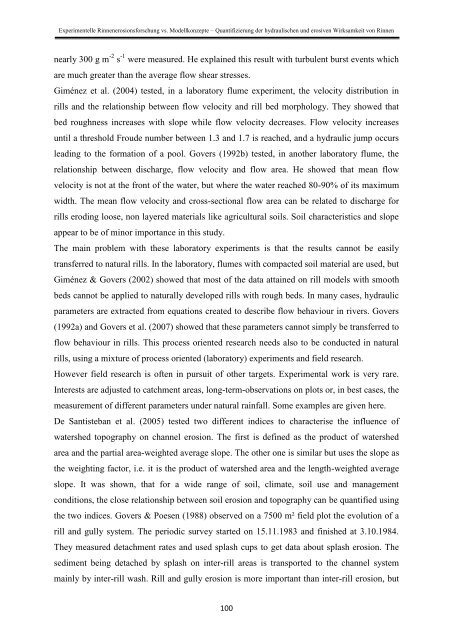Stefan Wirtz Vom Fachbereich VI (Geographie/Geowissenschaften ...
Stefan Wirtz Vom Fachbereich VI (Geographie/Geowissenschaften ...
Stefan Wirtz Vom Fachbereich VI (Geographie/Geowissenschaften ...
You also want an ePaper? Increase the reach of your titles
YUMPU automatically turns print PDFs into web optimized ePapers that Google loves.
Experimentelle Rinnenerosionsforschung vs. Modellkonzepte – Quantifizierung der hydraulischen und erosiven Wirksamkeit von Rinnen<br />
nearly 300 g m -2 s -1 were measured. He explained this result with turbulent burst events which<br />
are much greater than the average flow shear stresses.<br />
Giménez et al. (2004) tested, in a laboratory flume experiment, the velocity distribution in<br />
rills and the relationship between flow velocity and rill bed morphology. They showed that<br />
bed roughness increases with slope while flow velocity decreases. Flow velocity increases<br />
until a threshold Froude number between 1.3 and 1.7 is reached, and a hydraulic jump occurs<br />
leading to the formation of a pool. Govers (1992b) tested, in another laboratory flume, the<br />
relationship between discharge, flow velocity and flow area. He showed that mean flow<br />
velocity is not at the front of the water, but where the water reached 80-90% of its maximum<br />
width. The mean flow velocity and cross-sectional flow area can be related to discharge for<br />
rills eroding loose, non layered materials like agricultural soils. Soil characteristics and slope<br />
appear to be of minor importance in this study.<br />
The main problem with these laboratory experiments is that the results cannot be easily<br />
transferred to natural rills. In the laboratory, flumes with compacted soil material are used, but<br />
Giménez & Govers (2002) showed that most of the data attained on rill models with smooth<br />
beds cannot be applied to naturally developed rills with rough beds. In many cases, hydraulic<br />
parameters are extracted from equations created to describe flow behaviour in rivers. Govers<br />
(1992a) and Govers et al. (2007) showed that these parameters cannot simply be transferred to<br />
flow behaviour in rills. This process oriented research needs also to be conducted in natural<br />
rills, using a mixture of process oriented (laboratory) experiments and field research.<br />
However field research is often in pursuit of other targets. Experimental work is very rare.<br />
Interests are adjusted to catchment areas, long-term-observations on plots or, in best cases, the<br />
measurement of different parameters under natural rainfall. Some examples are given here.<br />
De Santisteban et al. (2005) tested two different indices to characterise the influence of<br />
watershed topography on channel erosion. The first is defined as the product of watershed<br />
area and the partial area-weighted average slope. The other one is similar but uses the slope as<br />
the weighting factor, i.e. it is the product of watershed area and the length-weighted average<br />
slope. It was shown, that for a wide range of soil, climate, soil use and management<br />
conditions, the close relationship between soil erosion and topography can be quantified using<br />
the two indices. Govers & Poesen (1988) observed on a 7500 m² field plot the evolution of a<br />
rill and gully system. The periodic survey started on 15.11.1983 and finished at 3.10.1984.<br />
They measured detachment rates and used splash cups to get data about splash erosion. The<br />
sediment being detached by splash on inter-rill areas is transported to the channel system<br />
mainly by inter-rill wash. Rill and gully erosion is more important than inter-rill erosion, but<br />
100
















